"Tudor Architecture" takes the name from the Tudor
monarchs who ruled England from 1485 when Henry Tudor, Earl of
Richmond, defeated King Richard III at the Battle of Bosworth
Field, to 1603, when Elizabeth I died. It's distinguished by half-timbering,
with an exposed wood frame filled in with plaster, brick, or stone.
The style continues today as Tudor Revival.
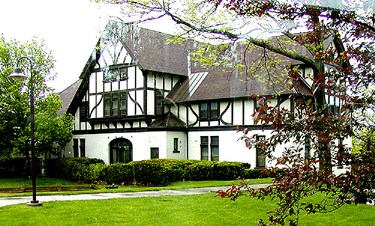
Tudor mansions dot the English landscape. In the reigns of Henry
VII and Henry the VIII, a family named Norris constructed a mansion
in Lancashire, on the north bank of the River Mersey.
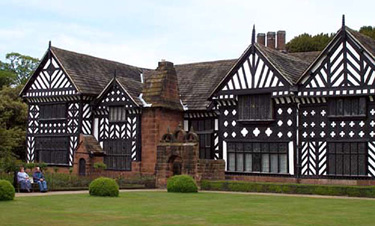
Speke Hall, Lancashire, England
"Speke," an Old English word for brushwood, was applied
to local roads, places. The Norris mansion is Speke Hall. Speke
Hall was completed in the late 16th century, about the time that
William Shakespeare was establishing a reputation as playwright
and poet in London. It is an outstanding example of Tudor architecture,
with a great hall, great parlour, wings, and gardens. The Norris
family remained Catholic after the Reformation, paying fines for
it. Speke Hall has secret rooms to hide Catholic priests. Thomas
Norris became a Protestant during the English Civil War of the
mid-17th century, but the Norrises being Royalist adherents to
King Charles I, their estate was seized by Oliver Cromwell's parliamentary
forces.
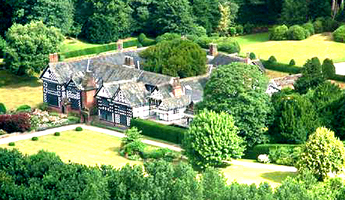
Speke Hall, aerial view
The family regained Speke Hall after the Restoration of Charles
II, but the enormous house could not be maintained and fell into
disrepair. It and the 2,400 acre-property were sold in 1795 for
£73,000 to a wealthy merchant, Richard Watt. Watt's descendants
restored Speke Hall and lived in it until 1943 when Miss Adelaide
Watt died and left the house to the National Trust. Part of the
property was sold before World War II and became the local airport.
Lancashire was divided in 1974 to form the separate county Merseyside.
The area is famous today for the city of Liverpool, home of the
Beatles. Liverpool Airport, on the Norris family's original property,
is now John Lennon Airport. Speke Hall, now maintained by the
National Trust, is open to the public. We will return to Speke
Hall.
 Percy
Tredegar Morgan was born in London in 1862, of a distinguished
family of Welsh origins. Morgan is a very Welsh name, and Tredegar
is a town in South Wales. After school in Merton, Surrey, Percy
Morgan entered Oxford University as a junior candidate, but left
when only 14 to take a position with the London accounting firm
Turquand, Youngs & Co.
Percy
Tredegar Morgan was born in London in 1862, of a distinguished
family of Welsh origins. Morgan is a very Welsh name, and Tredegar
is a town in South Wales. After school in Merton, Surrey, Percy
Morgan entered Oxford University as a junior candidate, but left
when only 14 to take a position with the London accounting firm
Turquand, Youngs & Co.
After learning bookkeeping, auditing, and other skills, he left
England for the United States at age 21 to take a position with
London's Victorine Gold Mining Company at the Kingston Mine in
Austin, Nevada. That he was skilled in business at an early age
is shown by his being promoted to superintendent in 1882, aged
only 20.
He subsequently went to Denver, Colorado opening an office with
an English partner, William Hanson, providing accounting, auditing,
and other business services. He became superintendent of the Republic
Mining and Smelting Company in Cooke City, Montana and may have
participated in a vigilante committee there.
Percy Morgan, c. 1892
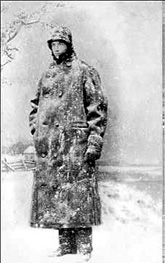 Percy
Morgan apparently found Montana's brutal winters intolerable,
and left about 1885 for San Francisco. Langley's San Francisco
Directory, a useful historical source, first lists him in 1887,
as "secretary Electric Development Co., 323 Pine Street,
residence Cosmo Club," obviously a bachelor residence.
Percy
Morgan apparently found Montana's brutal winters intolerable,
and left about 1885 for San Francisco. Langley's San Francisco
Directory, a useful historical source, first lists him in 1887,
as "secretary Electric Development Co., 323 Pine Street,
residence Cosmo Club," obviously a bachelor residence.
Young Montana mine superintendent Percy Morgan,
around 1885.
Morgan's business and accounting career progressed rapidly. He
was instrumental in organizing the Nevada Gypsum and Fertilizer
Company, Eureka Mining Company, and the Sunset Telephone-Telegraph
Company, which reorganized with Pacific Telephone & Telegraph.
The picture that emerges of Percy Morgan is of a focused, determined
individual. His was not a rags-to-riches story, like Abraham Lincoln's;
he began life with advantages and built on them. By 1892 Morgan
was a fixture in San Francisco's business community. About 1893
he married Fanny Babbit Ainsworth, called "Daisy," from
an affluent Oakland family. Langley's 1897 Directory gives Morgan's
address as 2213 Buchanan Street, just off Clay (the block is now
occupied by California-Pacific Medical Center).
About this time Morgan bought a 100-acre property just above today's
Foothill College. He joined the Pacific Union and Bohemian clubs.
At the end of the 19th century his business interests included
a directorship of the Union Trust Company and Wells Fargo Nevada
National Bank.
With several others Morgan formed the California Wine Association
(CWA), the largest wine-producing cooperative in the world, stimulating
the Napa and Sonoma wine industries. The great earthquake and
fires of April 18, 1906, the anniversary of which was just commemorated,
destroyed most of the CWA's San Francisco wine cellars. The CWA
relocated to Richmond, California, to a site still known as Winehaven.
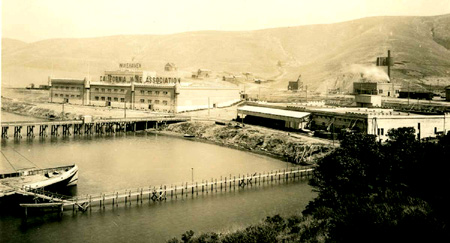
Wineheaven, Richmond, California, c. 1910
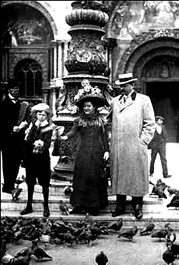 For
all his successes, Morgan was dogged by health problems, which
are obscure. In 1911, aged only 49, he retired on the recommendation
of his doctor from most of his business concerns. In those days
doctors prescribed rest in the form of a sea voyage to recover
from whatever ailed patients. Morgan and his family took a three-year
European sojourn.
For
all his successes, Morgan was dogged by health problems, which
are obscure. In 1911, aged only 49, he retired on the recommendation
of his doctor from most of his business concerns. In those days
doctors prescribed rest in the form of a sea voyage to recover
from whatever ailed patients. Morgan and his family took a three-year
European sojourn.
Percy Morgan, Jr. with his parents in Venice, c. 1911
Their visits to the continent - Austria, France, Switzerland
- are documented in photographs.
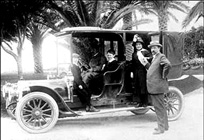
Daisy and Percy Morgan with sons Percy Jr.and Jack in the south
of France
They undoubtedly also saw much of the British Isles, including
Wales. As Speke borders on Wales, they likely also saw Speke Hall.
Percy Morgan's last entry in Langley's San Francisco Directory
was 1910, still on Buchanan Street.
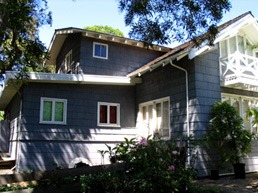 About
1910 Morgan had built a house called Little Gables on his Santa
Clara County property for his parents, come from England to retire.
About
1910 Morgan had built a house called Little Gables on his Santa
Clara County property for his parents, come from England to retire.
Little Gables, c. 2009
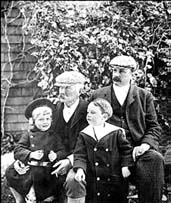 Here
is Morgan, his father, and sons John and Percy Jr.
Here
is Morgan, his father, and sons John and Percy Jr.
When he returned from Europe in 1914, he began construction at
the property of an enormous Tudor Mansion influenced by, though
not identical to, Speke Hall.
San Francisco architect John Powers designed an L-shaped structure
- Speke Hall is O-shape - of over 15,000 square feet. During construction
the Morgans apparently lived at Little Gables. The completed Tudor
mansion was named Lantarnam Hall (one L), after the district of
Llantarnam (two Ls), in Southeast Wales.
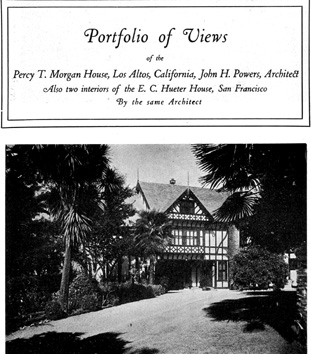 Construction,
furnishing, and decorating costs came to the enormous sum of about
$400,000. The house is on a hilltop just above Little Gables.
Construction,
furnishing, and decorating costs came to the enormous sum of about
$400,000. The house is on a hilltop just above Little Gables.
From "Architect and Engineer", May 1920
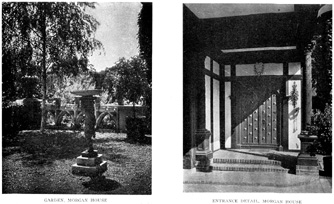
The main entrance is a stone archway. On the left is the house
proper; on the right is a great hall for entertaining.
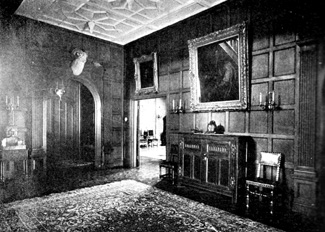 Inside
the main house is a great stair hall, supposedly a replica of
the one in Hatfield House, home of Hertfordshire's Cecil family.
Inside
the main house is a great stair hall, supposedly a replica of
the one in Hatfield House, home of Hertfordshire's Cecil family.
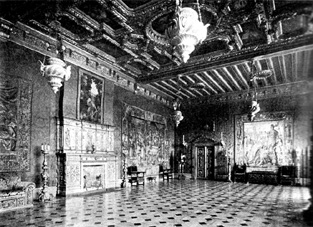
The house included a library, several bedrooms, a dozen fireplaces,
servants' quarters, and formal dining room. Furnishings, art objects,
and artifacts were acquired by Morgan during his European sojourn.
Morgan's construction of a British or European mansion is not
in itself unique. There are other British or continental European
mansions in the United States; William Randolph Hearst's San Simeon
Castle a conspicuous example. Some capitalists went the other
route of acquiring a palatial residence in Europe; Scottish immigrant
Andrew Carnegie bought Skibo Castle in northeastern Scotland.
Morgan's Llantarnam Hall is unique, however, in Santa Clara County.
Locally, only Filoli and the Carolands mansion in San Mateo County
compare, and Hearst's Wyntoon estate in Shasta County, unless
anyone can cite something I've overlooked.
On January 1, 1916 Dr. Ray Lyman Wilbur was inaugurated as third
president of Stanford University. On May 3rd Percy Morgan was
appointed to a ten-year term as trustee, replacing Frank Miller,
who retired due to ill health. Stanford Alumnus magazine
that spring reported
…Mr. Morgan was chosen for a place on the Stanford
board on account of his wide knowledge of banking and of organization
finance, which will be helpful to the trustees in their administration
of the $20,000,000 endowment from which the university derives
its income.
Mr. Morgan calls himself a retired businessman…but since
his return (from Europe) he has been called upon so often to
serve on committees and boards where his keen business judgment
would be invaluable that he has become one of the busiest men
in San Francisco… He is now…a member of the reorganization
committee of the People's Water Company of Oakland, the General
Petroleum Company and the San Francisco and Oakland Terminal
Railways; he is one of the Sloss Securities trustees who are
conserving and administering the Sloss estate; he is on the
executive committee of the Natomas Company of California, and
he is a director of the Union Trust Company and of the Wells
Fargo Nevada National Bank of San Francisco. He has a beautiful
home at Los Altos, only a few miles from the Stanford Campus.
Wilbur's administration made major changes: the introduction
of tuition, the quarter system, reorganization of athletics, opening
a new hospital, and a campus art gallery. As trustees were guarded
in their statements and records, we do not know how much Morgan
participated in debates or decisions. Certainly he was influential
about financial matters. Because of his extensive European travels
and personal art collections at Llantarnam Hall, Wilbur asked
Morgan's advice on the Stanford Museum collection. In a letter
to Wilbur, Morgan demurred that he was not an expert on Museum
objects, but would try to help decide what was attractive, and
what might induce other collectors to donate. Morgan himself donated
a firearms collection. Wilbur also asked Morgan's advice on the
new University library (Green Library, designed by Arthur Brown,
Jr.), on grounds, and on landscaping.
Personally, Morgan is hard to assess. He was conservative, even
elitist, with little sympathy for social criticism or workingmen.
He staunchly supported American entry into the "Great War,"
as World War I was called at first, in contrast to another Stanford
figure, Herbert Hoover, who was opposed. The Morgans had two sons,
Percy Jr. and John Ainsworth Morgan, but Percy Sr. made no attempt
to send either to Stanford, possibly considering it too new and
non-establishment. Percy Jr. took entrance examinations for Harvard
University but did poorly. Intervention by Ray Lyman Wilbur was
rebuffed by Harvard President Lawrence Lowell. Both sons attended
Princeton and served in World War I.
Early in 1920 Percy Morgan was injured in an automobile accident
near Salinas, California. Examination and treatment at Johns Hopkins
Hospital in Baltimore failed to bring recovery. Morgan came home
in such deep despondency - "depression" nowadays - that
his wife had him watched by servants and family. She should have
had his firearms removed. Early morning April 16, 1920 Morgan
stole out of his bedroom to a downstairs room, pointed a shotgun
at his chest, and pulled the trigger. He died instantly. Private
services were held at Lantarnam Hall.
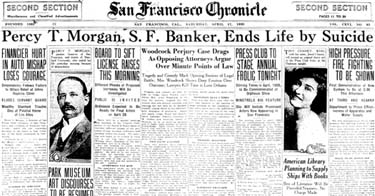
Please continue with
Part 2 of the presentation,
